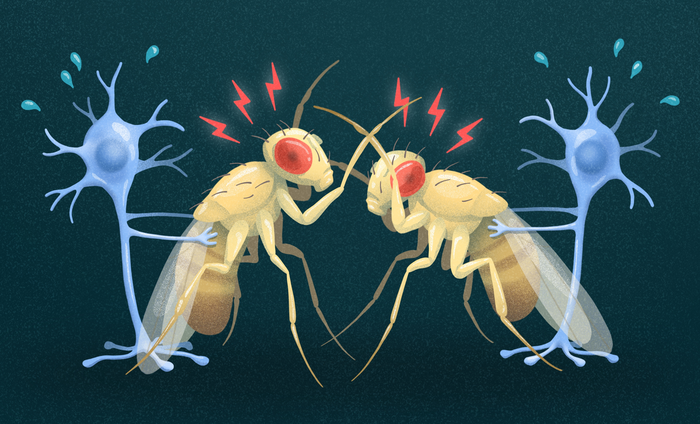The brain mechanisms that cause aggressive behavior have been well studied, but far less well understood are the mechanisms that tell the body when it’s time to stop fighting. A study by Salk scientists has now identified a gene and a group of cells in the brain that play a critical role in suppressing aggression in fruit flies. The researchers, led by Kenta Asahina, PhD, assistant professor in Salk’s Molecular Neurobiology Laboratory, say their findings could provide new insights into disorders such as Parkinson’s disease, which can sometimes cause behavioral changes like increased aggression and combativeness.
“We’ve found an important mechanism in the brain that normally prevents us from expressing high levels of aggression,” Asahina said. “Although our findings are in fruit flies, the same mechanism may be at play in humans, at least at the molecular level, which could help better explain a host of psychiatric diseases.”
Asahini and colleagues described their findings in Science Advances, in a paper titled, “A neurogenetic mechanism of experience-dependent suppression of aggression.”
Aggression is “an ethologically important social behavior,” the authors wrote, “but excessive aggression can be detrimental to fitness.” De-escalation, or the ability to decide when it’s time to stop fighting, is a vital behavior for survival because it allows animals to adjust their aggressiveness according to the costs and benefits of an encounter with a rival—at a certain point, continuing to fight is no longer worth it. Sensing when it’s time to de-escalate is complex because there isn’t an obvious trigger, such as the way fullness triggers an animal to stop eating.
Interestingly, and across species, the investigators continued, it’s been found that individuals reared as a group have markedly reduced aggressiveness compared with individuals reared in isolation. “This phenotype has been linked to social isolation–induced stress, with significant implications for human psychological and cognitive health.” But the precise mechanism by which the brain converts the social experience to lower levels of aggression remains poorly understood, they noted.
For their reported study, the scientists compared the behavior of normal Drosophila melanogaster fruit with that of fruit flies in which candidate genes were knocked down in neurons. “We used the fruit fly D. melanogaster to identify the genes necessary for suppressing aggression under group-rearing conditions, which plastically reduce aggression,” the team stated. “Although several mutations are known to make mice unusually aggressive, the neurogenetic mechanisms necessary for animals to reduce their levels of aggression in a social experience–dependent manner have not been well understood.”
Specifically, the investigators examined how frequently male flies lunged at other males, a typical aggressive behavior in this species. They found that flies missing a gene called nervy (nvy) were significantly more aggressive than their normal counterparts. The flies that lacked nervy weren’t initiating more aggressive interactions by chasing other flies. They were simply more likely to choose to fight over the course of a normal encounter.
The nervy gene isn’t actually involved in the animal’s moment-to-moment decision to stop fighting. Rather, it helps give the fly the ability to respond to environmental cues (likely the fly’s past experience with other individuals), the researchers suggested. “The function of nervy is to set up the nervous system in such a way that animals are ready to stop fighting when the right signal comes in,” said first author Kenichi Ishii, PhD, a former postdoctoral fellow in Asahina’s lab.
The researchers also used single-cell sequencing to look at how other genes were activated differently in flies that were missing the nervy gene, compared with normal flies. This allowed the team to identify other genes downstream from nervy that were involved in developing the de-escalation mechanism.
“Although flies are very different animals than humans, some of these mechanisms may be similar in both species. Uncovering the molecular basis of aggression may lead to a better understanding of how aggression is involved in certain types of psychiatric disorders,” said Asahina.

The authors also identified a small group of neurons in the brain that de-escalate fighting by using the nervy gene. “… nvy is specifically required in a subset of octopaminergic/tyraminergic (OA/TA) neurons to influence aggression,” they wrote. Octopamine/tyramine are the invertebrate counterparts of norepinephrine/epinephrine. However, the investigators further acknowledged, more work is necessary to understand the brain circuit that stops fighting.
For the next step, the researchers hope to precisely identify the group of neurons responsible for suppressing aggressive behavior. They also want to figure out at what stage of development the nervy gene is important for shaping the nervous system.
“Our findings illustrate a mechanism by which a dedicated group of neuromodulatory cells converts social experience into the appropriate level of aggression,” they concluded. “These findings provide insight into a common neural mechanism underlying experience-dependent suppression of aggressive behavior, a phenomenon widely observed from invertebrates to vertebrates.”







